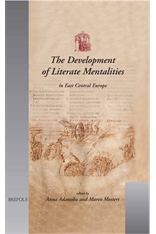|
The Development of Literate Mentalities in East Central Europe, ed. Anna Adamska and Marco Mostert (Turnhout, 2004: USML 9), viii+546 pp. ISBN 2-503-51449-9. Compared with most of mainland Europe north of the Alps. the introduction of writing in East Central Europe (Bohemia, Poland and Hungary) took place with a considerable delay. Much is known about East Central European uses of writing, although only a fragment of this knowledge is known outside the region. Gathered by historians, palaeographers and codicologists, diplomatists, art historians, literary historians and others, this knowledge has hardly ever been studied in the light of recent discussions on medieval literacy and communication. Work done in the Czech, Polish and Hungarian traditions of scholarship has never been sugjected to a comparative analysis. Furthermore, the question of the relations between writing and other forms of communication in the region remains largely unexplored. The volume serves a double purpose. For the first time, a collection of contributions on medieval literacy in East Central Europe is put before the forum of international scholarship. It is also hoped to further discussions of modes of communication, literate behaviour and mentalities among scholars working in the region. Contents: Anna Adamska, “The Study of Medieval Literacy: Old Sources, New Ideas” Part I: The Reception of Writing in Social Life Jiři Kejř, “Die Urkunde als Beweismittel im Gerichtsverfahren im mittelalterlichen Böhmen” Tomasz Jurek, “Die Rechtskraft von Urkunden im mittelalterlichen Polen” Thomas Wünsch, “Verschriftlichung und Politik in Rotrußland (14.-15. Jh.): Zum kulturgeschichtlichen Aussagewert mittelalterlicher Geschichtsaufzeichnungen” Katalin Szende, “The Uses of Archives in Medieval Hungary” Maria Koczedrska, “L’Utilisation de l’Écrit dans l’Administration du Diocèse de Cracovie au XVe Siècle” Part II: Litterati and Illitterati in Medieval East Central Europe László Veszprémy, “The Birth of a Structured Literacy in Hungary” S. Pavlicová and J. Třikač, “The Documentary Clerical Agenda of Prague’s Municipal Offices During the Middle Ages” Gábor Sarbak, “Über das mittelalterliche Bibliothekswesen der Benediktiner in Ungarn” Part III: The Role of the University: The Case of Cracow Paul W. Knoll, “Literary Production at the University of Cracow in the Fifteenth Century” Antoni Gąsiorowski, “Die Graduierten der Krakauer Universität im 15. Jh. im Lichte des Liber promotionum Facultatis Artium in Universitate Cracoviensi“ Part IV: Spoken Languages, Written Languages Hubert Łaszkiewicz, “Le Latin et le Ruthène Face aux Langues Vernaculaires sur le Territoire du Royaume de Pologne et du Grand-Duché de Lituanie aux XIVe et XVe Siècles” András Vizkelety, “Die deutsche Sprache und das deutsche Schrifttum im ungarischen Mittelalter” Ivan Hlávaček, “Dreisprachigkeit im Bereich der Böhmischen Krone: Zum Phänomen der Sprachbenutzung im böhmischen diplomatischen Material bis zur hussitischen Revolution” Edit Madas, “La Naissance du Hongrois Écrit” Part V: Traces of Oral Tradition in Medieval East Central European Societies Marie Bláhová, “Verschriftete Mündlichkeit in der böhmischen Chronik des Domherrn Cosmas von Prag” Piotr Dymmel, “Traces of Oral Tradition in the Oldest Polish Historiography: Gallus Anonymus and Wincenty Kadłubek” Gábor Klaniczay, “Speaking About Miracles: Oral Testimony and Written Record in Medieval Canonization Trials” Pavlína Rychterová, “Die Rezeption der Schriften der hl. Birgitta von Schweden in Böhmen in der 2. Hälfte des 14. und im 15. Jahrhundert” Part VI: Beyond Medieval Literacy: Political and Social Ritual Karel Hruza, “Ghostwriter Ihrer Majestät, der Krone von Böhmen: Fingierte Mündlichkeit, reale Schriftlichkeit und Legitimation satirischer hussitischer Propaganda” Urszula Borkowska OSU, “Theatrum Ceremoniale at the Polish Court as a System of Social and Political Communication” Part VII: Beyond Medieval Literacy: Reading Images, Folklore, the Printed Word František Šmahel, “Das Lesen der unlesbaren Inschriften: Männer mit Zeigestäben” Krisztine Fügedi, “Modifications of the Narrative? The Message of Image and Text in the Fourteenth-Century Hungarian Illuminated Chronicle” Krzystof Bracha, “Folklore der Schrift: Einige Zeugnisse des Spätmittelalters Mittelosteuropas” István György Tóth, “Illiterate and Latin-Speaking Gentlemen: The Many Faces of the Hungarian Gentry in the Early Modern Period” Part VIII: Whither the Study of East Central European Literacy? Stanisław Bylina, “Quelques Conclusions” Gábor Klaniczay, “A View from Inside” Ivan Hlaváček, “Marginale Überlegungen zum Studium der nichtdiplomatischen Schriftkultur des frühen und hohen Mittelalters in Böhmen” |
||
Medieval Literacy Platform
Faculty of Humanities


